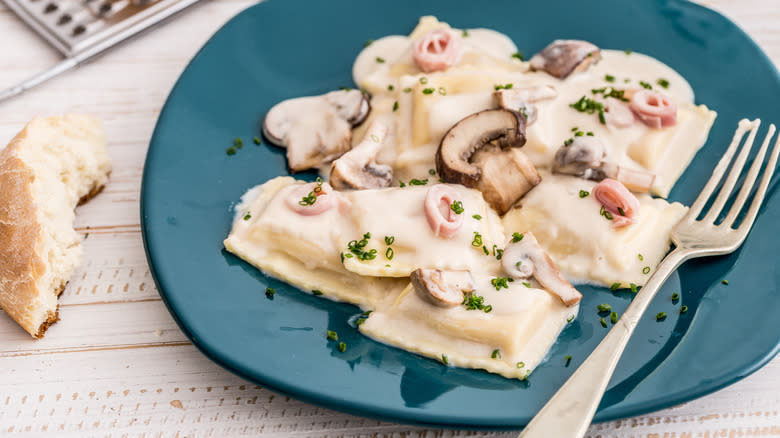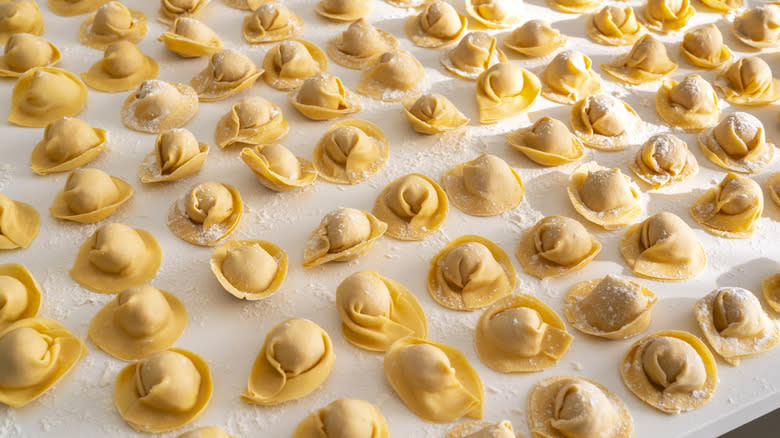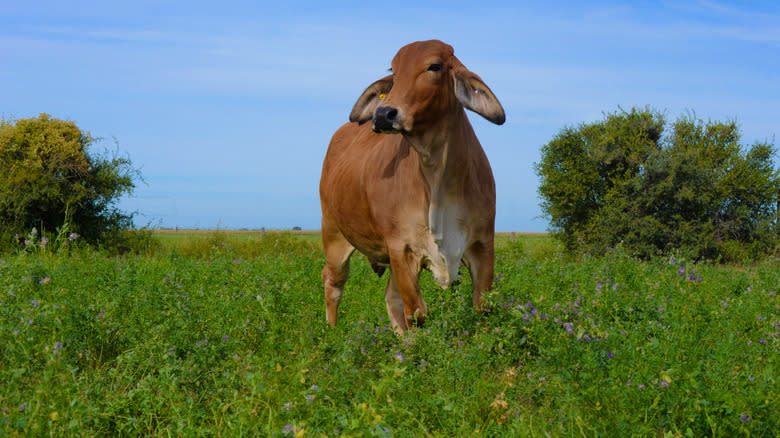Salsa Caruso Is A Deliciously Rich Uruguayan Pasta Sauce With Italian Roots

Salsa Caruso (or Caruso Sauce) is the crab rangoon of Italian food because it appears to come from one country but was actually invented in another (and that's where the two dish's similarities end). Crab rangoon is an example of American-Chinese cuisine, a style resembling food from the latter country but invented in the former. If Salsa Caruso had to be given that kind of umbrella term, it would be called Uruguayan-Italian: Made from cream, mushrooms, cheese, and ham, it certainly sounds Italian, but was actually invented in Uruguay's capital of Montevideo. Regardless, it's utterly delicious on pasta.
According to Mario César Monzeglio, who was in the kitchen on the day in 1954 when Salsa Caruso was invented and was the first to try the dish, the original sauce consisted of mushrooms sautéed in butter, heavy cream, ham, and something called "meat extract" (more on that later). Its creator was Raimondo Monti, head chef at Montevideo's famous Mario y Alberto restaurant. A native Piedmontese, Monti was an Italian immigrant and Gold Medal of Gastronomy winner at the 1936 World Exhibition in Paris. While living in Uruguay, Monti invented "Capeletis a la Caruso," a dish featuring his new sauce coating a stuffed Italian pasta from the Romagna region called cappelletti.
Read more: French Cooking Tricks You Need In Your Life
Cappelletti: The Little Hats

Cappelletti resembles another stuffed pasta from the same region, tortellini, but tends to be larger in size. Stuffed with meat and cheese and then boiled, cappelletti resemble the brimmed, large-domed hats favored by peasants in the region and are referred to by the same name: Galonza. Mario y Alberto was famous for its stuffed pasta dishes featuring ravioli, tortellini, and agnolotti, and Monti was looking for a signature way of presenting cappelletti on the menu as well.
While there might be quite a bit of variance concerning which meats and cheeses are used to stuff cappelletti, it's universally agreed that the pasta must be served with a rich meat broth. Back in Uruguay, Raimondo Monti used what he had to hand: Liebig's Extract of Meat. According to the Uruguayans who honor the chef to this day as the architect of Uruguayan-Italian cuisine, this was an inspired choice.
Extract Of Meat: A Beefy Backstory

Invented nearly 90 years before Capeletis a la Caruso, Liebig's Extract of Meat was a commercially produced liquid beef broth with Uruguayan roots. Dark brown, viscous, and meaty-smelling, the extract was produced by boiling about 30 pounds of trimmed meat particles in water to form one pound of pasty goo. Its inventor, George Christian Giebert, was a road builder in South America who couldn't help but notice all of the large-scale cattle production in the region and decided to take advantage. Giebert teamed up with the Liebig company and the partnership founded its first extraction factory in the port town of Fray Bentos, on the Uruguay River. Despite early claims of Liebig's Beef Extract as a nutrient-dense health tonic being thoroughly debunked (dogs fed exclusively on the stuff actually died), it nevertheless became a household staple in South America and Europe, and later found its way into Monti's cappelletti dish.
Having created a dish that would justly become world famous, Monti had one thing left to do: Give it a name. He chose to honor a personal hero, the legendary Italian opera singer Enrico Caruso, who had performed in Uruguay in 1917 during a wildly successful South American tour. If you want to make his namesake dish today, feel free to skip the extract of meat and use cubes of beef bouillon instead.
Read the original article on Daily Meal.


